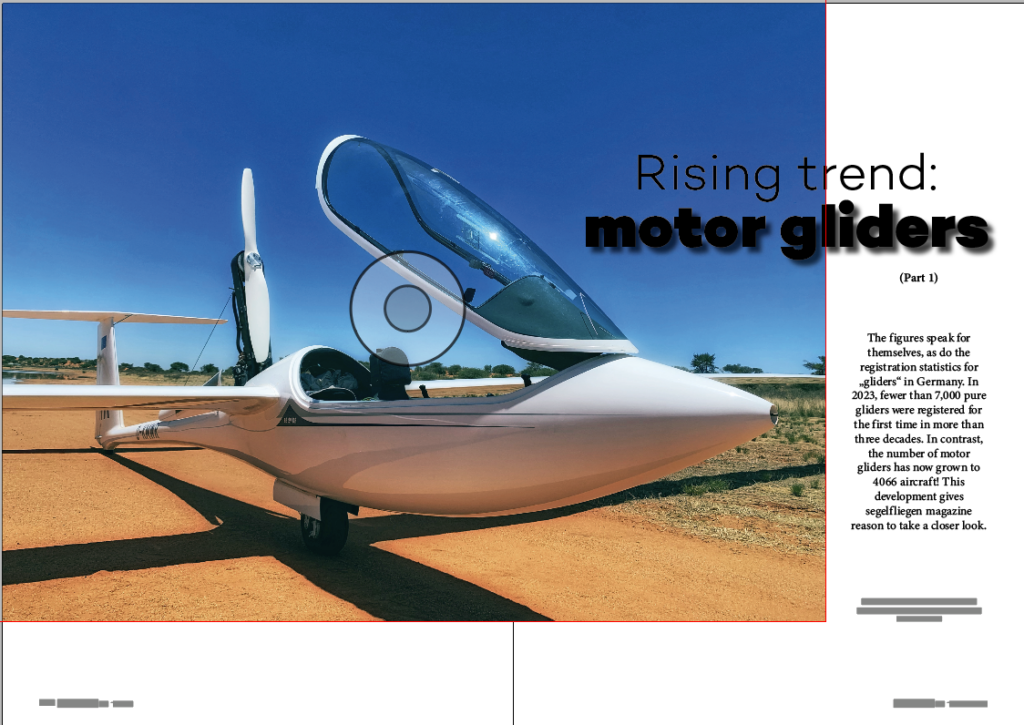The latest issue with top articles for all those who want to be well informed about this wonderful sport: Our new series on powered gliders highlights all aspects of the trendy aircraft, we introduce the new, perfect co-pilot, the brand new app from WeGlide, take a look at the weather situation, flight options, wave flying and flight safety at the Porta and the gravity waves in the low mountain range, get to the bottom of a quick day at the World Championships in Australia, take a look at lightning over the Namib from the cockpit and find out how dangerous a lightning strike can be for a glider, how to protect yourself and what is go and no-go in the vicinity of thunderstorms. However, safety starts before the flight. This is where we find out whether we are really well prepared for the start, whether we are fit and whether we have set up our glider with full concentration and carried out all safety checks conscientiously. To ensure that we get into the air safely, we take a closer look at the take-off dynamics during the winch launch. If you want to fly 1,000 km with an old standard class glider, you can‘t rely on the glide ratio alone: you also need to add some positive energy as our report on the Spanish energy lines shows. Our summer trip to Sweden and our story from the cockpit show why it’s worth sticking to your goals and not giving up so quickly. And now, enjoy reading! Order here.
And here’s a look at the current magazine:

In our new series in the „Flight Safety“ section, we are devoting ourselves to the topic of „motor gliders“. We cover everything from training to the various phases of flight (preparation, take-off, cruising, landing, post-processing) and avoidable emergencies. We will highlight the subtle, but also the clear differences to pure gliding, which can lead to typical accidents in powered glider operations.
With power in the air
Powered gliders are aircraft with one or more engines that can also have the characteristics of a glider when their engines are switched off – this is the official definition. In Germany, Austria and Switzerland, they belong to a separate aircraft category and have specific registrations such as D-Kxxx, OE-9yyy, or HB-2zzz.
The desire to be able to glide well with light aircraft existed early on. After numerous experiments and smaller series, the first „Scheibe Falke SF25“ were launched at the beginning of the 1960s. Of the more than 2000 units built, many are still in use today to acquire numerous class ratings and to extend gliding licenses with TMG approvals or self-launching authorisations.
It goes without saying that the requirements for a self-launch authorisation on a modern high-performance glider are completely different from those on a classic that has been tried and tested for decades. Not only the pure gliding performance plays a role, but also the aircraft geometry and size make different demands. Nevertheless, the engines of the most modern aircraft are sometimes surprisingly similar to the antiquated models from the middle of the last century, which are still powered by the (lawnmower) technology of the time. But more on that later!
An important difference that plays a significant role in training and obtaining ratings is the distinction between „touring motor gliders“ (TMG) and „sailplanes with self-sustainer“.
A touring motor glider (TMG) with a permanently mounted, non-retractable engine and non-retractable propeller must be able to take off and climb under its own power. As a rule, the focus here is on the powered flight characteristics. The Stemme S10/12 with its folding propeller is a major exception. Despite its good cruising characteristics in motorized flight, it also offers excellent gliding characteristics with a glide ratio of more than 50. This unique combination has made the Stemme famous on expeditions far off the beaten track – and stands for a spirit of adventure and boundless passion, as its own advertising says, with certain compromises in the pure gliding characteristics, of course.
Gliders with an auxiliary engine sometimes offer even better gliding characteristics with (almost) no risk of landing. While not all have the capability to self-launch, they may have a glide ratio of 60 or more and are supposedly completely independent. This combination has made them extremely popular over the last three to four decades. Nowadays, almost all current gliders are also available with a wide variety of engines – with all their advantages and disadvantages, as we shall see!
The whole article can be found in the current issue of soaring international

